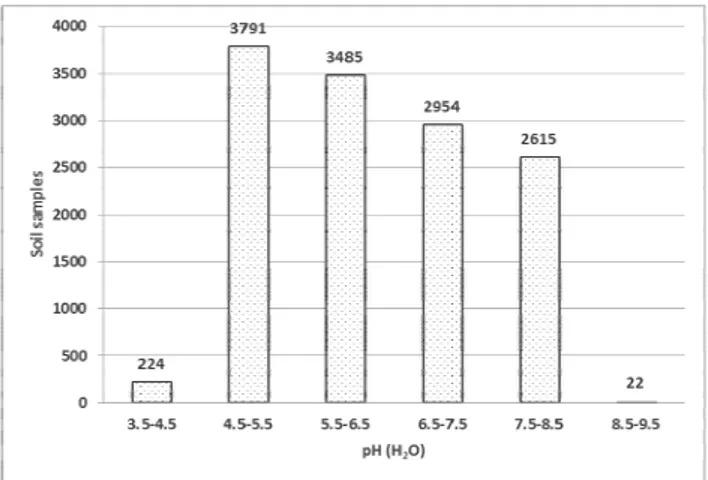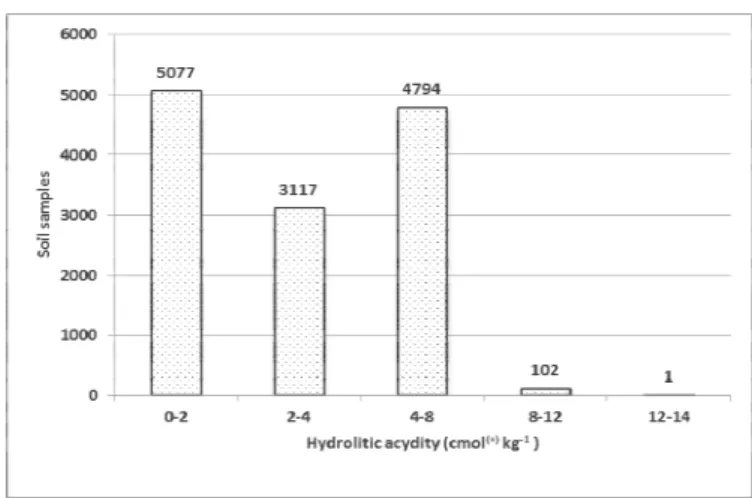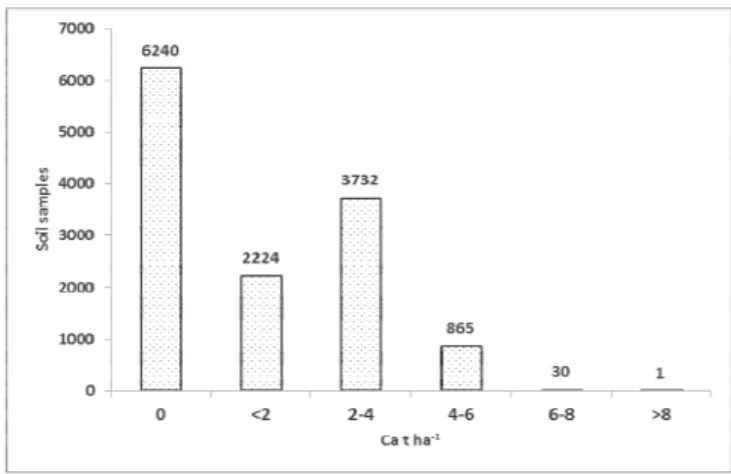LIMING OF ACID SOILS IN OSIJEK-BARANJA COUNTY
Boris Đurđević1*, Vladimir Vukadinović1, Blaženka Bertić1, Irena Jug1, Vesna Vukadinović1, Mladen Jurišić1,
Željko Dolijanović2 and Martina Andrijačić1
1
Faculty of Agriculture, Osijek, Trg Svetog Trojstva 3, 31000 Osijek, Croatia 2Universitiy of Belgrade, Faculty of Agriculture, Nemanjina 6,
11080 Beograd-Zemun, Serbia
Abstract: The negative trend of soil degradation process increases with intensive agricultural production. Therefore, there is a need for soil conditioning like liming, humification, fertilization, etc. to improve soil quality. One of the major problems that occur on agricultural soils of Croatia is acidification. A downward trend of soil pH is mainly present in soils of poor structure with intensive agricultural production. In agricultural practice liming often needs to rely only on the pH value, without determining the hydrolytic acidity, CEC or soil texture. Due to the above mentioned facts, calculation of liming for Osijek-Baranja County was conducted with the help of ALRxp calculator, which takes CEC, soil pH in KCl, hydrolytic acidity, bulk density of soil, soil textural class and depth of the plow layer to 30 cm into account. Low soil pH values have a great influence on soil suitability for crops as well as on the deficit of calcium and magnesium. All of these lead to the degradation of soil structure, and can even lead to disturbances of plant nutrition in some production areas. On such soils, liming would be imperatively required, but with caution because an excessive intake of lime materials, especially without the necessary analysis, causes a decline in organic matter and reduces accessibility for plant uptake of microelements.
Key words: liming, acid soils, pH, calculator, plant nutrition.
Introduction
The main task of any agricultural production is to achieve better quality of plants with higher yields. Soil has an important role in how to achieve this, because it supplies the plant with water, air and nutrients needed for growth and development. But with intensification of agricultural production the trend of soil degradation is higher (inadequate soil management, intake of nutrients in the soil, agrotechnics, etc.). Therefore, there is a need for conditioning of soil, fixing the
quality of soils like liming, humification, fertilization, etc. (Carter et al., 1997). In agricultural practice, a need for liming often relies on the soil pH, without determining the hydrolytic acidity, sorption capacity of soil and its texture. The necessary soil analyses are very rarely performed, which in practice often leads to irreparable damage of soils, with a rapid decline in organic matter, phosphorus and trace elements (Vukadinović et al., 2008). Low soil pH leads to numerous problems, like a deficit of calcium and magnesium, toxicity of aluminum, manganese, reduced availability of phosphorus, low efficiency of nitrogen and potassium fertilizers, necrosis of leaves and fruits, slow plant growth, poor soil structure, etc. (Vukadinović et al., 2009). Therefore, the aim of this paper is to show the importance of liming as an obligatory measure recommended for conditioning of acid soils, and a new approach in calculating liming doses (combining computer models with the actual chemical data).
Materials and Methods
Soil samples are collected during the period between 2003 and 2009 (seven years) in the eastern part of Croatia (Osijek-Baranja County). For the preparation of this work 13,092 samples of soil were selected and used for laboratory analysis. Soil samples were taken with agrochemical or hydraulic automatic probe, on average with 25 stitches per sample. The sampling depth was 0 to 30 cm. The geographical position of each sample and elevation (absolute) is determined by the GPS device (measurement error < = 5 m). Soil samples were taken after the harvest (from 20 June to 30 September), before any fertilizer was applied to the soil. Soil samples were ground in a soil mill and analyzed in the laboratory for the sake of the following chemical properties of soil. The soil pH in water and KCl was determined in soil samples using a laboratory pH meter, and hydrolytic or potential soil acidity was activated with hydrolytic alkaline salts (Na-acetate). This reaction produces acetic acid, whose amount is determined by titration with 0.1 N NaOH (Vukadinović and Bertić, 1988). Humus was defined using bicromat method (wet combustion method with K-bicromat) and measured with spectrophotometer (585 nm) (Vukadinović and Bertić, 1988). The cation exchange capacity was expressed in cmol(+) kg-1 and calculated by the empirical formula using computer program ALRxp (Vukadinović et al., 2001):
Eq. (1)
CEC_hum = 150 IF pH (KCl) < 4.5
Soil bulk density was expressed in g cm-3 and also empirically calculated using computer program ALRxp (textural group was estimated by ‘feel’ method, in the field and then calculated (Vukadinović et al., 2001).
The required dosage of calcium for liming was calculated for crops and was expressed in Ca t ha-1 for the arable layer of 30 cm, using the following formula (Vukadinović et al., 2001):
Eq. (2)
Catxha-1 = dosage of calcium for liming; TBS% = target base saturation of cation exchange capacity; BS% = base saturation of cation exchange capacity; pv = soil bulk density; CEC = cation exchange capacity.
Results and Discussion
The average soil pH value (H2O) was 6.30, and in pH-KCl, it was 5.50 (Table 1). The highest measured soil pH value (H2O) was 8.84 and the lowest 3.94 (Table 1). Extremely acid soil reaction was determined in 224 samples analyzed from 13,092; strongly acid in 3,791 samples, 3,485 samples were moderately acid, 2,954 were neutral, slightly alkaline soil reaction was detected in 2,615 samples, and strongly alkaline soil reaction was determined in 22 samples of soil (Figure 1).
Figure 1. pH (H2O) in analyzed soil samples.
hydrolytic acidity (Figure 2). The average value was 2.83 cmol(+) kg-1 of soil with a high coefficient of variation of 88.23% (Table 1).
Figure 2. Hydrolytic acidity of soil samples.
Values of hydrolytic acid > 4 cmol(+) kg-1 indicate a high saturation of the soil adsorption complex with acidic ions and in this case it is necessary to consider the need for liming, of course, with an additional analysis, primarily to determine the status of humus, phosphorus and microelements (Vukadinović et al., 2009). Cation exchange capacity of the soil (CEC) was 9.49 to 26.05 cmol(+) kg-1 (Table 1).
Table 1. Chemical characteristics of soil.
pH KCl pH H2O Hy cmol(+) kg-1 Humus % CEC cmol(+) kg-1 g·cm-3
Average 5.50 6.30 2.83 2.18 13.44 1.40
Min. 3.37 3.94 0.00 0.32 9.49 1.20
Max. 8.20 8.84 13.99 6.92 26.05 1.75
Sd 1.22 1.10 2.50 0.78 2.24 0.08
Cv 22.21 17.50 88.23 35.73 16.70 5.81
In this paper, a required amount of calcium for the liming was calculated using ALRxp calculator (Vukadinović et al., 2001) which calculates the required dose of calcium (calcium doses of liming were expressed in Ca t ha-1 for the arable layer of 30 cm) and it also takes into account:
a) saturation of CEC with bases (BS%), b) pH in KCl,
c) Hy (hydrolytic acidity), d) soil bulk density (ρ in g cm-3), e) soil texture classes,
f) the depth of plow layer to 30 cm.
The first step is to estimate the value of a CEC based on analyzed humus in the soil and textural class using formula:
Eq. (3)
Saturation of the CEC with bases is calculated using this formula:
Eq. (4)
In the end, with the estimated CEC, the target level of saturation with bases (TBS%) of required dose for liming is calculated using the formula:
Eq. (5)
Target saturation of CEC with bases (% TBS) depends on the size of CEC: a) when the CEC is < 19 cmol(+) kg-1, TBS is 90%,
b) when CEC is between 20-28 cmol(+) kg-1, TBS is up to 85%, c) for CEC > 28 cmol(+) kg-1, TBS is 80%.
All the results are then converted and expressed as the amount of CaCO3 t ha-1 (Figure 3). Of the total of analyzed samples in the Osijek-Baranja County liming had to be done in 6,852 (52.33%) soil samples, whereas liming was not necessary in 6,240 (47.66%) samples (Figure 3 and 4).
known that the low pH value reduces the soil suitability for crops and this statement is confirmed by several authors (for corn Adeoye and Singh, 1985; wheat Patiram and Prasad, 1990; soybean Bell, 1996, etc.).
Figure 3. The dose of calcium for liming.
The soils of the western and southwestern part of Osijek-Baranja County are mostly acid with some neutral soils that are very likely limed (Figure 4).
Liming must be seriously considered Liming is not necessary
One of the common agricultural measures for raising the soil pH is liming (Gery and Mayron, 2001), but it should be noted that the problem of low pH values cannot be solved easily and quickly. A change from very strongly acid to neutral soil reaction, radically changes the conditions in the soil. The quick oxido-reduction changes which occur in soil lead to an increased decomposition of soil organic matter (humus). Because of this, after initial growth (caused by liming), a drop of soil productivity inevitably follows. Therefore, for extremely acid soils, liming should be more moderate (like fertilizing with calcium) with an extended activity of calcium for several years (3-5). Hence, the calculated needs for liming must be based on chemical soil analysis, each intensive liming of extremely and very acid soils must be accompanied by humification and fertilization of soil (Karalić, 2009; Vukadinović et al., 2009).
Conclusion
On the territory of Osijek-Baranja County, over a period of seven years (2003-2009), 13,092 soil samples were analyzed. With the help of ALRxp calculator, a dose for liming was calculated for each sample, and it is concluded that: in 6,240 (47.66%) samples, liming as a measure of repairing the soil quality was not necessary; in 6,852 (52.33%) soil samples, liming must be seriously considered.
The influence of low soil pH reaction has reduced soil suitability for crops as well as calcium and magnesium availability, and consequently has lead to deterioration of soil structure, and in some production areas, it can even lead to a disturbance of available nutrition for crops, mostly caused by toxic concentrations of aluminum, iron or manganese. Liming should be obligatory on such soils. It should also be noted that excessive intake of lime materials, particularly without a necessary analysis, caused the decline in soil organic matter and micronutrients which became less accessible for uptake by the plants.
In the end, we can conclude that the soils with extremely low soil pH reaction cannot be quickly and easily conditioned.
References
Adeoye, K.B., Singh, L. (1985): The effect of bulk application of lime under two tillage depths on soil pH and crop yield. Plant Soil 85:295-297.
Bell, P.F. (1996): Predicting liming needs of soybean using soil pH, aluminum and manganese soil tests. Commun. Soil Sci. Plant Anal. 27:2749-2764.
Carter, M.R., Gregorich, E.G., Anderson, D.W., Doran, J.W., Janzen, H.H., Pierce, F.J. (1997): Cocepts of soil quality and their significance. Soil Science 25:1-19.
Đurđević, B. (2010): Ekspertni model procjene pogodnosti zemljišta za usjeve. Doktorska disertacija. Poljoprivredni fakultet, Osijek, Hrvatska.
Karalić, K. (2009): Utvrđivanje potrebe u kalcizaciji i utjecaj kalcizacije na status hraniva u tlu. Doktorska disertacija, Poljoprivredni fakultet, Osijek, Hrvatska.
Manrique, L.A., Jones, C.A., Dyke, P.T. (1991): Predicting cation exchange capacity from soil physical and chemical properties. Soil Sci. Soc. Am. J. 55:787-794.
Patiram, R.N., Prasad, R.N. (1990): Frequency of lime application to wheat-maize crop sequence on an acid soil of Sikkim. J. Indian. Soc. Soil Sci. 38(4):723-726.
Quirine, K., Kristen, S., Beckman, J., Miller, J. (2006): Agronomy fact sheet series 6: lime recommendations for field crops. Nutrient management spear program http://nmsp.css.cornell.edu.
Vukadinović, V., Bertić, B. (1988): Praktikum iz agrokemije i ishrane bilja. Poljoprivredni fakultet, Osijek, Hrvatska.
Vukadinović, V., Lončarić, Z., Bertić, B., Teklić, T. (2001): AL-calculator for crop fertilization recommendation “on line”. In: Zhang, W.L., Chen, G.X. (Eds.), Proceedings of the 12th World Fertilizer Congress, Fertilizer, Food Security and Enviromental Protection. Bejing, China, pp. 249-250.
Vukadinović, V., Vukadinović, V., Jug, I., Kraljičak, Ž., Đurđević, B. (2008): Geostatistički model procjene potrebe za kalcizacijom tala Osječko-baranjske županije. Poljoprivreda 14(2):11-16. Vukadinović, V., Bertić, B., Kos, M., Grabić, A., Vukadinović, V., Jug, I., Glavaš, R., Đurđević, B.
(2009): Zbrinjavanje saturacijskog mulja kalcizacijom kiselih tala Osiječko-baranjske županije. Zbornik radova znastveno stručnog skupa, Tehnologije zbrinjavanja otpada i zaštite tla. Zadar, Hrvatska, pp. 29-37.
KALCIZACIJA KISELIH ZEMLJIŠTA U OSJEČKO-BARANJSKOJ ŽUPANIJI
Boris Đurđević1*, Vladimir Vukadinović1, Blaženka Bertić1, Irena Jug1, Vesna Vukadinović1, Mladen Jurišić1,
Željko Dolijanović2 i Martina Andrijačić1
1
Poljoprivredni fakultet u Osijeku, Trg Svetog Trojstva 3, 31000 Osijek, Hrvatska 2
Univerzitet u Beogradu, Poljoprivredni fakultet, Nemanjina 6, 11080 Beograd-Zemun, Srbija
R e z i m e
Negativan trend procesa degradacije zemljišta povećava se sa intenzivnom poljoprivrednom proizvodnjom. Zato postoji potreba za poboljšanjem zemljišnih osobina đubrenjem, kalcizacijom, humifikacijom, itd. Jedan od najvećih problema koji se javljaju na poljoprivrednim zemljištima Hrvatske je kiselost. Trend snižavanja pH vrednosti je uglavnom prisutan na loše strukturnim zemljištima sa intenzivnom poljoprivrednom proizvodnjom. U poljoprivrednoj praksi potrebe za kalcizacijom često se oslanjaju samo na pH vrednost, bez utvrđivanja hidrolitičke kiselosti, CEC ili teksturu zemljišta. Shodno navedenim činjenicama, određivanje količine sredstava za kalcizaciju u Osječko-baranjskoj županiji je sprovedeno uz pomoć ALRxp kalkulatora, koji uzima u obzir količinu CEC-a, pH u KCl zemljišta, hidrolitičku kiselost, zapreminsku masu zemljišta, volumnu gustoću, pripadnost teksturnoj klasi i dubinu oraničnog sloja do 30 cm. Niske pH vrednosti zemljišta imaju veliki uticaj na izbor i pogodnost useva koji ćemo gajiti, kao što znamo zbog nedostatka kalcijuma i magnezijuma. Sve ovo dovodi do degradacije strukture zemljišta, a u nekim proizvodnim područjima može čak dovesti do poremećaja u ishrani bilja. Kalcizacija je neophodna upravo na takvim zemljištima, ali uz oprez, jer prekomerni unos kreča, posebno bez neophodne analize, izaziva pad organske materije i smanjuje pristupačnost mikroelemenata neophodnih za biljke.
Ključne reči: kalcizacija, kisela zemljišta, pH vrednost, kalkulator, ishrana bilja.
Primljeno: 9. novembra 2011. Odobreno: 1. decembra 2011.


